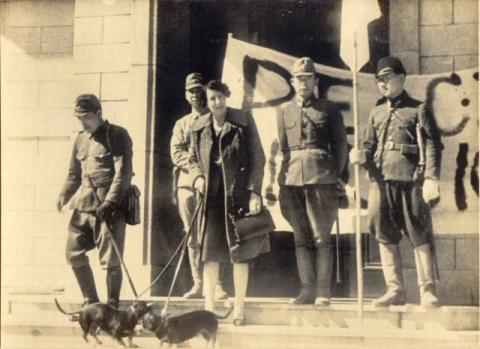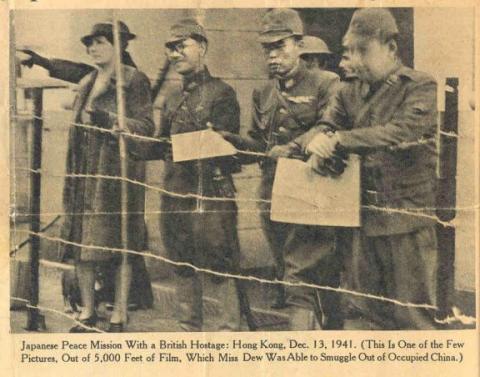Edith Hamson, her children May and Richard, her mother Mrs. Wood and her younger sister Leilah, are all at Kowloon Hospital. As the sun comes up, the first Japanese soldier appears - 'in his wake followed an army of soldiers, who began to tear the place apart':
Screams of terror echoed through the corridors...it was apparent that they were intoxicated with a brutal rage. They set about destroying hospital equipment...I saw doctors and orderlies with bloody faces, and some of the nurses had been beaten and knocked to the floor.
Soon the entire building is in Japanese hands and they are prisoners. The water is off, and they are given only small portions of rice and 'a few extra pieces from the hospital kitchen'. ((See note below))
Military withdrawal from Kowloon is completed by about 8.30 a.m. Half an hour later, the Japanese, now holding the Mainland, send over a 'peace mission' asking Governor Sir Mark Young to surrender to avoid an all-out assault on the Island. Two women, Mrs. C. R. Lee, wife of a senior official, and Mrs. MacDonald, are taken across the harbour with them as hostages. Mrs. Lee brings her two dachshunds. Mrs MacDonald is pregnant and needs to get to hospital - Mrs. Lee made taking her a condition of participation.
American writer Gwen Dew and reporter Vaughn Meisling photograph and interview the participants. They're then taken away for questioning by 'good-looking' policeman and future author George Wright-Nooth.
The peace mission leaving Kowloon:
Gwen Dew's photograph of the mission on Hong Kong island:
Newspaper reports of the peace mission:
The Governor rejects the peace proposals out of hand. The Japanese are not ready to land on the Island yet. While making their preparations, they attack military targets with an intensive campaign of shelling and bombing. This begins immediately with shells falling in the crowded districts of Kennedy Town and West Point. Chinese casualties are heavy, and there are too many fires for the Fire Brigade to extinguish. The devastation of whole areas depresses civilian morale.
Jesuit Father Thomas Cooney goes to minister at the French Hospital (St. Paul's) in Causeway Bay:
(H)e found the whole place transformed from the orderly, smoothly-running hospital which he knew, with a convent and school beside it, to a much more complicated war-time institution. The ordinary patients had been moved away to one of the buildings on the race-course in Happy Valley, and the whole hospital was taken over by the government for Chinese civilian casualties. Provision was made in the hospital proper for 300 patients.
The hospital's under the Government-appointed Dr. Dean Smith.
Father Cooney is welcomed by the sisters, as priests from nearby St. Margaret's haven't been able to get through to say mass for some days. He's given a room on the second floor and he 'realised with a certain amount of dismay that there was only a ceiling and a tiled floor between him and visiting areoplanes'. They don't bother him the first night, but that's the last night's untroubled rest he's to have for some time.
Noel Croucher, passing along the seafront, notices every pane of plate glass has been broken by the Jeanette explosion.
Arthur Morse, based in London, has been looking after the affairs of the HSBC. Today he receives a letter from Sideny Caine of the Colonial Office telling him that Vandeleur Grayburn has wired asking for an Order-in-Council to be prepared transferring the Bank's Head Office from Hong Kong to London with Morse as Acting Chief Manager. Grayburn wants this to be put into effect only if the Bank falls into enemy hands. Morse waits for further instructions, but none come, and on December 15th he will arrange to take control and on the 16th he will wire all branches to say that the Head Office is now in London and no instructions from Hong Kong should be acted on until confirmed from there. Morse has good reason to take these steps: he fears that the Bank's assets will be frozen in the United States if its Head Office falls into enemy hands.
The Daily Mirror does its best to stay positive:
Page 1
In Hong Kong our advanced posts have been withdrawn, but Chinese are attacking the rear flank of the Japanese there.
Page 8, Continued from page 1:
Hong Kong Outposts Retired
Japanese pressure on our advanced positions at Hong Kong has caused us to withdraw in the direction of Kowloon, but this movement is from our advanced positions only.
Chinese forces under the direct command of General Chiang Kai Shek are cutting off the Japanese from the rear and back in their attempts to take Hong Kong.
Sources:
Hamson: Allana Corbin, Prisoners of the East, 2002, 83-85
Peace Mission: Tony Banham, Not the Slightest Chance, 2003, 69-70
Mrs. Lee, 'good-looking': Gwen Dew, Prisoner of the Japs, 1943, 33-35
The Governor rejects: John Luff, The Hidden Years, 1967, 57-58
Cooney: Thomas F. Ryan, Jesuits Under Fire In The Siege of Hong Kong, 1944, 75-76
Croucher: John Luff, The Hidden Years, 1967, 50
Arthur Morse: Maurice Collis, Wayfoong, 1965, 219-220
Note: Kowloon Hospital
Oliver Lindsay (The Lasting Honour, 1978, 61) dates the arrival of Japanese troops in the Hospital as 5 p.m. on December 12. Dr. Newton's diary account (Captive Christmas, 1979, 51 - and see yesterday's entry) is his probable source, although it seems from Newton's account that it was a Japanese doctor who arrived at 5 p.m. and the soldiers with fixed bayonets, mentioned by Lindsay, came a few hours later.
If I have reconstructed the chronology of Allana Corbin's narrative correctly, the troops are said to enter on the fourteenth. As the description clearly begins at dawn, I've placed it on December 13 on the assumption that Mrs. Hamson became aware of the presence of the soldiers at this time because a more complete occupation of the kind she describes was taking place.
But, as this note shows, the fear and uncertainty of the time are reflected in the confusion of the sources. Further research is obvously necessary, but it might not yield a clear and indisputable chronology.
Note: Peace Mission
John Luff's The Hidden Years (1967, page 57) claims that Mrs. MacDonald was 'an invalid' and she was on the launch in order to be taken to hospital. Gwen Dew (my source above) says it was a Russian woman who was pregnant. Again, it's not surprising that descriptions of these events are sometimes confused and contradictory.



